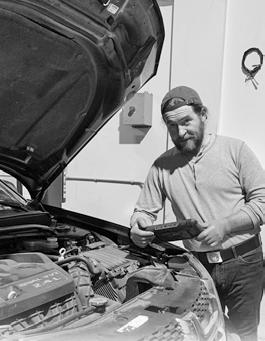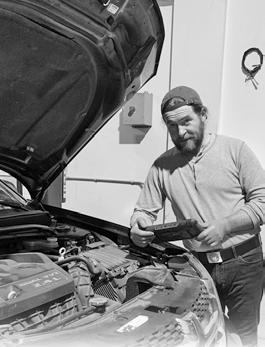
7 minute read
On the Road . . . . . . . . 18 and
Police quick action brings dangerous incident to an end
By Lori Larsen
The quick action and first-rate training of Camrose Police Service members ensured an extremely dangerous situation was handled without further incident while maintaining the safety of the public, officers and persons involved.
On January 19, Camrose Police Service received a 911 telephone call regarding a male who had passed out behind the wheel of an idling vehicle. The caller also advised that there was, what appeared to be a shotgun, beside the driver.
Police members attended the area and surrounded the idling vehicle. When the driver of the suspect vehicle awoke, he reversed the vehicle into a parked Camrose Police vehicle, causing extensive damage.
The suspect then tried to flee the scene in the vehicle, which had sustained a flat tire from being punctured by a spike belt deployed by the police.
“This was most definitely a dynamic situation that unfolded very quickly in daytime hours in our city’s east end,” said Camrose Police Service Inspector John Corbett.
The male suspect surrendered to police after getting the stolen vehicle stuck in deep snow.
“These types of events highlight the seriousness of the auto theft issue that we have in our province and the high level of risk that our citizens and officers are exposed to when offenders flee from the police,” reminded Corbett.
The 33-year-old male suspect, a prolific offender, is facing 16 charges including: possession of a prohibited firearm, dangerous operation of a motor vehicle, possession of stolen property and flight from police.
The suspect is in custody waiting on a bail hearing.
“I would like to commend our responding members and bystanders who were on scene, for their quick thinking, professionalism and cooperation in resolving this situation quickly and safely.
“The main thing, as always, is that no one was hurt, and that everyone went home safe.”
RED SEAL AUTO SERVICE TECHNICIAN


Reliable service. Electrical diagnostics. Can fix all makes & models.
We repair, you explore! 3831D-44 Ave., Camrose • 780-678-0393
$49 includes filter and lube Oil & Filter Change SPECIAL
*Synthetic Oil $64
Up to 6 litres of conventional oil*, gas engines Cars, Light Trucks, SUVs
Diesel engine Oil and Filter Change SPECIAL
up to 13 litres synthetic oil $119
D&D Vehicle Sales & Service
3760-48 Ave., Camrose 780.672.4400 www.ddsales.com Journeyman Technicians on staff!
Green Action Committee speaks to health risks of vehicle idling
By Lori Larsen
In an effort to build awareness of the impact idling automobiles have on our health and the environment, on behalf of the Camrose Green Action Committee (CGAC), chair Rob Hill made a presentation to City of Camrose council during the January 17 Committee of Whole meeting. “We need to raise the awareness of the health impact of automobile exhaust,” expressed Hill.
“The World Health Organization estimates that 7 million people die every year from air pollution, mostly from the burning of fossil fuels.”
He added that the Canadian Medical Association (CMA) connects automobile exhaust with asthma, cancer and heart disease.
The report also indicated that 21,000 premature deaths are attributable to air pollution in Canada each year, nearly nine times higher than the number of deaths due to motor vehicle collisions.
“We (Green Action Society) believe that the threat proposed by automobile exhaust is profound and the scientific evidence is clear and that most residents of Camrose have no idea that automobile exhaust is this hazardous to our health and we believe that people would want to know.”
A second document included in the presentation to council outlined the actions that the Green Action Committee believes council could take to reduce automobile idling in Camrose and a list of local organizations that support this initiative.
Ask of council
The Camrose Green Action Committee suggested the following actions to reduce automobile idling in Camrose. 1. No Idling signs should be erected to mark designated no idling zones. Designated zones would be areas with heavy pedestrian
traffic and within a certain distance of the entrance to schools, day cares, recreation facilities and health facilities. 2. Adopt a bylaw making it illegal to idle a vehicle for more than three minutes in designated zones. 3. An information package will be put together that explains the idling restrictions and gives the reasons why the restrictions are important. The information package should be sent to sports and other community groups for distribution and will be available for residents from City Hall and other City facilities. 4. A public information campaign involving The Booster, the City website and community groups will be engaged to make residents understand the idling regulations and why they are being introduced.
Hill said, “We believe that an education campaign to raise awareness of the need to reduce idling is far better than a heavy-handed enforcement approach, and once people understand the impact of idling exhaust on children’s health, their behaviour will change.”
Hill also pointed out the opportunities Camrose has as a trial member of the Alberta Capital Airshed (ACA). “That membership allows us access to a variety of resources and collaboration opportunities in the area of air quality.”
Hill indicated that other communities have bylaws that may focus on No Idling zones, where vulnerable people may be and include exemptions for extreme temperatures, emergency vehicles and unloading passengers.
“Other communities also show leadership through fleet policies governing staff idling, which also takes operational requirements, emergencies and extreme temperatures into account.”
Hill said the Airshed also supplied the CGAC with information on designing an awareness campaign that is informative, encouraging and non-punitive.
“They have an ongoing research and monitoring program that provides us with real-time information on our City’s overall air quality,” said Hill, adding that the ACA also has educational videos available. “The ACA will also soon be partnering with an Environmental Science class at Augustana to use wearable sensors to collect data on individual exposure to air pollution including where vehicles are idling.
“If we want to improve air quality and address the health impacts of vehicle idling in our community, the experience of the Airshed and other member municipalities can guide us in engaging with Camrosians in a positive way on this issue.”
Council inquires
Councillor Don Rosland asked, “Has there been any contact with school divisions and what they have to say?”
Hill responded that the first contact with the schools was deflected to the school divisions, adding that the Catholic School Division seemed to have no interest (in the proposal by CGAC) and the Battle River School Division indicated they had their own policy that they would work within.
Councillor Joy-Anne Murphy indicated that she is in support of the education component, and asked if Hill feels the CGAC is heading toward a bylaw.
Hill said, “The bylaw for me is a touchy issue. The last thing you want to do is get people’s backs up. We definitely don’t want to be going around ticketing people–that is an extreme last resort. I have a sense from other communities that it is not a bad thing to have a bylaw in the books if it is needed and it does provide some kind of guidance, but you really don’t want to be going there. I think that we should talk to other communities that have bylaws and ask them what their experience is, but we go into this as education campaign. We want to raise awareness.”
Mayor PJ Stasko asked Camrose Police Service Inspector Rene Brisson for input on the matter of a bylaw.
Inspector Brisson indicated that sometimes the intent of the bylaw is not for enforcement. “Obviously, if the bylaw is written with an enforcement piece, you are still left with dealing with complaints and education and awareness and, at some point, community members are looking for the next step.
“If a bylaw was in enacted and there was an enforcement clause in the bylaw, we do have a peace officer as well as police officers who enforce bylaws quite routinely. Depending on where the priorities fall, this could be something that could lead to enforcement if deemed appropriate.”
Councillor Lucas Banack agreed that there should be an educational campaign and was curious as to whether or not there had been any studies, particular on Camrose (or communities of similar size), on the impact idling has on health.
Hill replied, “I don’t know of studies in our area that have measured the health impacts of idling. I know that there is information about reducing the amount of idling, mostly anecdotally.”
Councillor David Francoeur asked what other Alberta muncipalities are doing, specifically education or bylaws or both, and what would happen when extreme temperatures occur.









